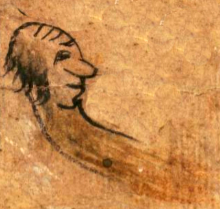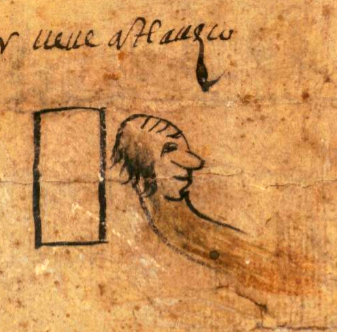Huehueatlauhco (CQ)
This compound glyph for the place name Huehueatlauhco ("At the Ancient Ravine") consists of two prominent elements. One is the head of an old man (huehue). His head is shown in profile facing to the viewer's right. He is bald on the top of his head, with prominent wrinkles there, and his remaining hair is thinning and ragged at the back. He has a large nose. Coming out from the base of his neck and going to the right seems to be a flow of water. This seems to be a reference to a ravine (atlauhtli) where water flows.
Stephanie Wood
ueue atlauhco
Huehueatlauhco
Stephanie Wood
covers ruling men and women of Tecamachalco through 1593
Randall Rodríguez and Stephanie Wood
place, lugar, name, nombre, nombres de lugares

huehue, an old man, https://nahuatl.wired-humanities.org/content/huehue-0
atlauh(tli), ravine (with a water flow), https://nahuatl.wired-humanities.org/content/atlauhtli
-co (locative suffix), in or at, https://nahuatl.wired-humanities.org/content/co
Huehue Atlauhco “In the Gorge of the Old Men.” Matthew T. McDavitt, “Placenames in the Codex Quetzalecatzin,” unpublished essay shared 2-21-2018.
En el Arroyo o el Río del Viejo
Ofelia Cruz Morales
The Codex Quetzalecatzin, aka Mapa de Ecatepec-Huitziltepec, Codex Ehecatepec-Huitziltepec, or Charles Ratton Codex. Library of Congress. https://www.loc.gov/item/2017590521/
The Library of Congress, current custodian of this pictorial Mexican manuscript, hosts a digital version online. It is not copyright protected.



